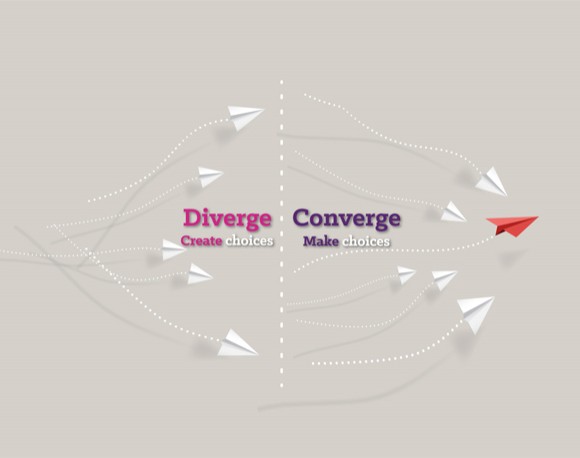Article Design thinking in 5 steps to generate business success in the cloud
Cloud transition requires changes not only in technology, but also in business strategy. What do customers want? How do you restructure your existing products, services and solutions to their needs? How do you ensure business success in the cloud? One way of addressing these issues and arriving at new, creative solutions is with design thinking.

Von / 21 May 2020 / Themen: Cloud
Design thinking – the needs of people
Design thinking is a creative five-step problem solving process that can be used for adapting to change. During this process it is essential to have an open mind and to avoid seeking validation or judgement of what is right or wrong, something that is often easier said than done. The focus is on people, on empathizing and connecting with the needs of your customers, instead of first coming up with a product or service and then researching how to sell it. Tim Brown, CEO of IDEO and one of the early adopters of design thinking defines the process perfectly in just one sentence:
“Design thinking is a human-centered approach to innovation that draws from the designer's toolkit to integrate the needs of people, the possibilities of technology, and the requirements for business success.”
Tim Brown, CEO of IDEO
Step into your customers’ shoes
An important part of cloud adoption is aligning business strategy with the new environment. How do you incorporate cloud benefits such as scalability, data security, efficiency and cost reduction into the services you want to provide to your customers? Design thinking is a structured and effective method to get off the beaten track and stimulate creativity and problem solving. It helps to step into the shoes of your customers and develop a curious mindset to really understand their needs and desires. Design thinking helps you find the intersection between three central questions: what is desirable from a human point of view, what is technologically feasible and economically viable?

Design thinking: five stages
Design thinking is set up in five stages: empathize, define, ideate, prototype and test. While the five stages seem to have a linear order, design thinking usually follows an iterative route and it is not uncommon to repeat several stages until reaching a solution that truly connects to the needs of your customers.
Design Thinking Process

Stage 1: Empathize – Get to know your customers and their needs
The first stage of design thinking is the research stage where you go out and experience what your customers are experiencing. Step into their shoes, experience their pains, be curious about them and their business, with empathy and without judgement. Try to get a real insight into their hopes and fears. Where are they heading for?
Stage 2: Define – formulate the core problem
In this stage you start to reframe what you have found. State the needs and fears of your customers while refraining from judgments and assumptions. The idea is to dig deeper into the core of what your customers are experiencing and what you have observed. Remember to adopt a human-centered approach in your problem statement.
Stage 3: Ideate – create ideas, think out of the box
Here you start creating ideas based on the insights acquired in the two previous stages. Use creative techniques such as brainstorming and visualizing to think out of the box. Try to come up with as many ideas as possible. Diverge. The more ideas, the better the result. Remember to create a safe environment without judgement for this stage. After gathering as many ideas as possible, it is time to converge. This means that you need to narrow down the ideas to the best ones which you will use to prototype a solution.
Tips for the Ideation Stage
Collect ideas individually on Post-it notes, so that everyone feels free without fear of being judged. Accept that not all ideas are perfect or can be used.
Go outside, go for a walk, go to a new or unusual environment to find inspiration.
Look at different industries and see how others address similar problems.
View the situation/problem from as many different angles as possible; try to formulate as many ideas as possible.

Stage 4: Prototype – design the first best possible solution
Now you are ready to prototype a solution. Keep it basic (minimally viable) and build the best possible solution with minimal cost. In this stage it can be helpful to gather feedback on the prototype from a small group of customers and team members in the organization. Remember that you may have to go back to redefine ideas and prototypes.
Stage 5: Test – Try to refine the solution
With the collected feedback from the previous stages, you now design the best possible solution in terms of desirability, feasibility and viability. This solution is ready to be tested with your customers and in your organization. Keep in mind that you are testing to learn; not validate. Often new insights and improvements emerge over time and you will most likely need to repeat one or more of the design thinking stages to continue refining the solution.
Design thinking for Service Providers
Moving IT services to the cloud is a big change for many Service Providers and the level of change is different for each individual company. From integrating a single cloud service into your existing portfolio to expanding the business strategy with new IT solutions or exploring new markets. Design thinking is a creative method to help you adapt to this change. By empathizing with your customers, you will be able to generate business success in the cloud.
Explore the Insight Cloud Journey framework if you are interested in learning more about cloud adoption for Service Providers or visit IDEO to learn more about design thinking in general.